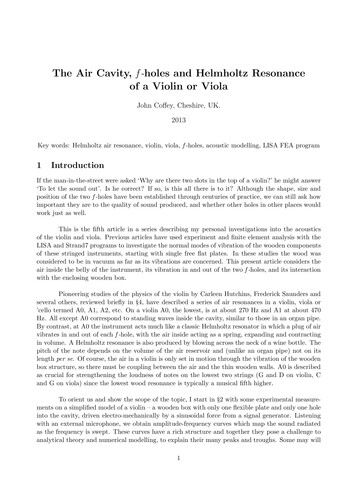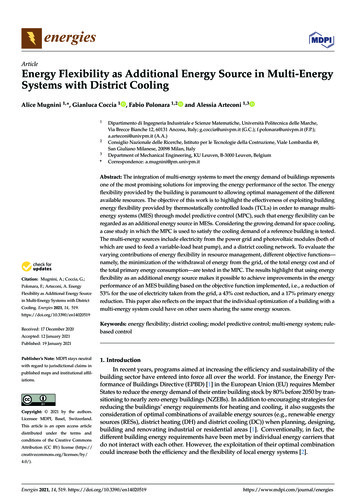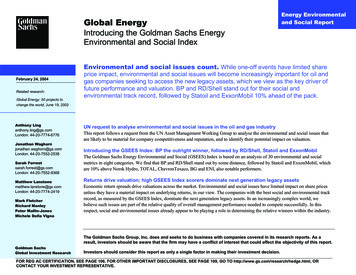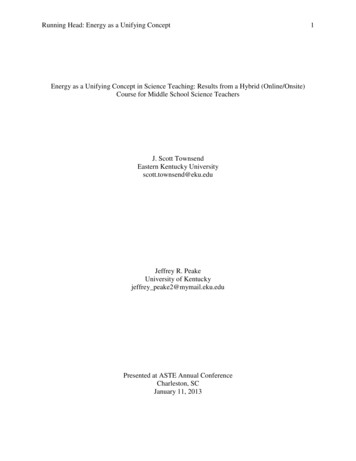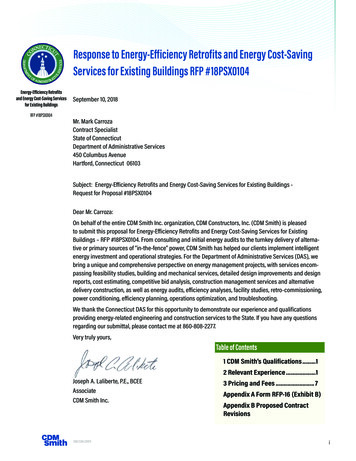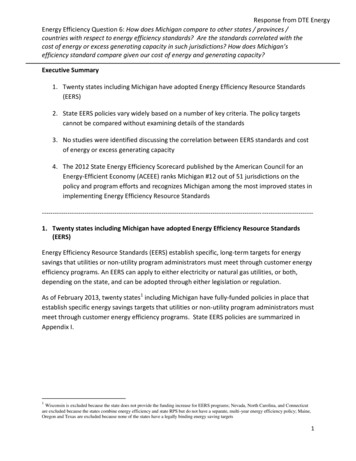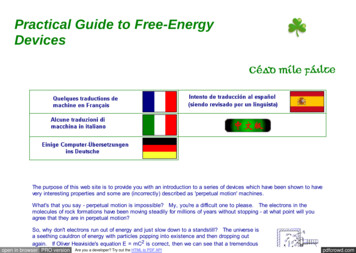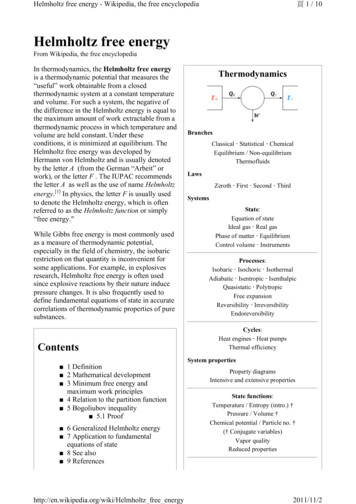
Transcription
Helmholtz free energy - Wikipedia, the free encyclopedia頁 1 / 10Helmholtz free energyFrom Wikipedia, the free encyclopediaIn thermodynamics, the Helmholtz free energyis a thermodynamic potential that measures the“useful” work obtainable from a closedthermodynamic system at a constant temperatureand volume. For such a system, the negative ofthe difference in the Helmholtz energy is equal tothe maximum amount of work extractable from athermodynamic process in which temperature andvolume are held constant. Under theseconditions, it is minimized at equilibrium. TheHelmholtz free energy was developed byHermann von Helmholtz and is usually denotedby the letter A (from the German “Arbeit” orwork), or the letter F . The IUPAC recommendsthe letter A as well as the use of name Helmholtzenergy.[1] In physics, the letter F is usually usedto denote the Helmholtz energy, which is oftenreferred to as the Helmholtz function or simply“free energy."While Gibbs free energy is most commonly usedas a measure of thermodynamic potential,especially in the field of chemistry, the isobaricrestriction on that quantity is inconvenient forsome applications. For example, in explosivesresearch, Helmholtz free energy is often usedsince explosive reactions by their nature inducepressure changes. It is also frequently used todefine fundamental equations of state in accuratecorrelations of thermodynamic properties of puresubstances.Contents 1 Definition 2 Mathematical development 3 Minimum free energy andmaximum work principles 4 Relation to the partition function 5 Bogoliubov inequality 5.1 Proof 6 Generalized Helmholtz energy 7 Application to fundamentalequations of state 8 See also 9 Referenceshttp://en.wikipedia.org/wiki/Helmholtz free energyThermodynamicsBranchesClassical · Statistical · ChemicalEquilibrium / Non-equilibriumThermofluidsLawsZeroth · First · Second · ThirdSystemsState:Equation of stateIdeal gas · Real gasPhase of matter · EquilibriumControl volume · InstrumentsProcesses:Isobaric · Isochoric · IsothermalAdiabatic · Isentropic · IsenthalpicQuasistatic · PolytropicFree expansionReversibility · IrreversibilityEndoreversibilityCycles:Heat engines · Heat pumpsThermal efficiencySystem propertiesProperty diagramsIntensive and extensive propertiesState functions:Temperature / Entropy (intro.) †Pressure / Volume †Chemical potential / Particle no. †(† Conjugate variables)Vapor qualityReduced properties2011/11/2
Helmholtz free energy - Wikipedia, the free encyclopedia頁 2 / 10 10 Further readingProcess functions:Work · HeatMaterial propertiesDefinitionSpecific heat capacity c The Helmholtz energy is defined as:[2]T1V1Thermal expansion α VCompressibility β where A is the Helmholtz free energy (SI:joules, CGS: ergs), U is the internal energy of the system(SI: joules, CGS: ergs), T is the absolute temperature (kelvins), S is the entropy (SI: joules per kelvin,CGS: ergs per kelvin).The Helmholtz energy is the negative Legendretransform with respect to the entropy, S, of thefundamental relation in the energy representation,U(S, V, N). The natural variables of A are T, V, N.Mathematical developmentFrom the first law of thermodynamics we have,where U is the internal energy, δQ is the energyadded by heating and δW is the work done by thesystem. From the second law of thermodynamics,for a reversible process we may say thatδQ TdS. Also, in case of a reversible change,the work done can be expressed as δW pdVApplying the product rule for differentiation to d(TS) TdS SdT, we have:,and:The definition of A U - TS enables to rewritethis ashttp://en.wikipedia.org/wiki/Helmholtz free energyProperty databaseEquationsCarnot's theoremClausius theoremFundamental relationIdeal gas lawMaxwell relationsTable of thermodynamic equationsPotentialsFree energy · Free entropyU(S,V)H(S,p) U pVHelmholtz free energy A(T,V) U TSGibbs free energy G(T,p) H TSInternal energyEnthalpyHistory and culturePhilosophy:Entropy and time · Entropy and lifeBrownian ratchetMaxwell's demonHeat death paradoxLoschmidt's paradoxSynergeticsHistory:General · Heat · Entropy · Gas lawsPerpetual motionTheories:Caloric theory · Vis vivaTheory of heatMechanical equivalent of heatMotive powerPublications:"An Experimental Enquiry Concerning . Heat""On the Equilibrium of Heterogeneous Substances"2011/11/2
Helmholtz free energy - Wikipedia, the free encyclopediaThis relation is also valid for a process that is notreversible because A is a thermodynamic functionof state.Minimum free energy andmaximum work principlesThe laws of thermodynamics are only directlyapplicable to systems in thermal equilibrium. Ifwe wish to describe phenomena like chemicalreactions, then the best we can do is to considersuitably chosen initial and final states in whichthe system is in (metastable) thermal equilibrium.If the system is kept at fixed volume and is incontact with a heat bath at some constanttemperature, then we can reason as follows.Since the thermodynamical variables of thesystem are well defined in the initial state and thefinal state, the internal energy increase, ΔU, theentropy increase ΔS, and the work performed bythe system, W, are well-defined quantities.Conservation of energy implies:The volume of the system is kept constant. Thismeans that the volume of the heat bath does notchange either and we can conclude that the heatbath does not perform any work. This impliesthat the amount of heat that flows into the heatbath is given by:頁 3 / 10"Reflections on theMotive Power of Fire"Timelines of:Thermodynamics · Heat enginesArt:Maxwell's thermodynamic surfaceEducation:Entropy as energy dispersalScientistsDaniel BernoulliSadi CarnotBenoît Paul Émile ClapeyronRudolf ClausiusHermann von HelmholtzConstantin CarathéodoryPierre DuhemJosiah Willard GibbsJames Prescott JouleJames Clerk MaxwellJulius Robert von MayerWilliam RankineJohn SmeatonGeorg Ernst StahlBenjamin ThompsonWilliam Thomson, 1st Baron KelvinJohn James WaterstonThe heat bath remains in thermal equilibrium at temperature T no matter what the system does.Therefore the entropy change of the heat bath is:The total entropy change is thus given by:Since the system is in thermal equilibrium with the heat bath in the initial and the final states, T isalso the temperature of the system in these states. The fact that the system's temperature does notchange allows us to express the numerator as the free energy change of the system:http://en.wikipedia.org/wiki/Helmholtz free energy2011/11/2
Helmholtz free energy - Wikipedia, the free encyclopedia頁 4 / 10Since the total change in entropy must always be larger or equal to zero, we obtain the inequality:If no work is extracted from the system thenWe see that for a system kept at constant temperature and volume, the total free energy during aspontaneous change can only decrease, that the total amount of work that can be extracted is limitedby the free energy decrease, and that increasing the free energy requires work to be done on thesystem.This result seems to contradict the equation dA SdT PdV, as keeping T and V constantseems to imply dA 0 and hence A constant. In reality there is no contradiction. After thespontaneous change, the system, as described by thermodynamics, is a different system with adifferent free energy function than it was before the spontaneous change. Thus, we can say thatwhere the Ai are different thermodynamic functions of state.One can imagine that the spontaneous change is carried out in a sequence of infinitesimally smallsteps. To describe such a system thermodynamically, one needs to enlarge the thermodynamicalstate space of the system. In case of a chemical reaction, one must specify the number of particles ofeach type. The differential of the free energy then generalizes to:where the Nj are the numbers of particles of type j and the μj are the corresponding chemicalpotentials. This equation is then again valid for both reversible and non-reversible changes. In caseof a spontaneous change at constant T and V, the last term will thus be negative.In case there are other external parameters the above equation generalizes to:Here the xi are the external variables and the Xi the corresponding generalized forces.Relation to the partition functionA system kept at constant volume and temperature is described by the canonical ensemble. Theprobability to find the system in some energy eigenstate r is given by:wherehttp://en.wikipedia.org/wiki/Helmholtz free energy2011/11/2
Helmholtz free energy - Wikipedia, the free encyclopedia頁 5 / 10Z is called the partition function of the system. The fact that the system does not have a uniqueenergy means that the various thermodynamical quantities must be defined as expectation values. Inthe thermodynamical limit of infinite system size, the relative fluctuations in these averages will goto zero.The average internal energy of the system is the expectation value of the energy and can beexpressed in terms of Z as follows:If the system is in state r, then the generalized force corresponding to an external variable x is givenbyThe thermal average of this can be written as:Suppose the system has one external variable x. Then changing the system's temperature parameterby dβ and the external variable by dx will lead to a change in log Z:If we writeas:we get:This means that the change in the internal energy is given by:In the thermodynamic limit, the fundamental thermodynamic relation should hold:http://en.wikipedia.org/wiki/Helmholtz free energy2011/11/2
Helmholtz free energy - Wikipedia, the free encyclopedia頁 6 / 10This then implies that the entropy of the system is given by:where c is some constant. The value of c can be determined by considering the limit T 0. In thislimit the entropy becomes S klog Ω0 where Ω0 is the ground state degeneracy. The partitionfunction in this limit iswhere U0 is the ground state energy. Thus, we see that c 0 andthat:Bogoliubov inequalityComputing the free energy is an intractable problem for all but the simplest models in statisticalphysics. A powerful approximation method is mean field theory, which is a variational methodbased on the Bogoliubov inequality. This inequality can be formulated as follows.Suppose we replace the real Hamiltonian H of the model by a trial Hamiltonian , which hasdifferent interactions and may depend on extra parameters that are not present in the original model.If we choose this trial Hamiltonian such thatwhere both averages are taken with respect to the canonical distribution defined by the trialHamiltonian , thenwhere A is the free energy of the original Hamiltonian and is the free energy of the trialHamiltonian. By including a large number of parameters in the trial Hamiltonian and minimizingthe free energy we can expect to get a close approximation to the exact free energy.The Bogoliubov inequality is often formulated in a sightly different but equivalent way. If we writethe Hamiltonian as:where H0 is exactly solvable, then we can apply the above inequality by definingHere we have definedto be the average of X over the canonical ensemble defined by H0.Sincedefined this way differs from H0 by a constant, we have in oltz free energy2011/11/2
Helmholtz free energy - Wikipedia, the free encyclopedia頁 7 / 10And thus the inequalityholds. The free energythatis the free energy of the model defined by H0 plus. This meansand thus:ProofFor a classical model we can prove the Bogoliubov inequality as follows. We denote the canonicalprobability distributions for the Hamiltonian and the trial Hamiltonian by Pr and, respectively.The inequality:then holds. To see this, consider the difference between the left hand side and the right hand side.We can write this as:Sinceit follows that:where in the last step we have used that both probability distributions are normalized to 1.We can write the inequality as:where the averages are taken with respect toprobability distributions:. If we now substitute in here the expressions for thehttp://en.wikipedia.org/wiki/Helmholtz free energy2011/11/2
Helmholtz free energy - Wikipedia, the free encyclopedia頁 8 / 10andwe get:Since the averages of H andare, by assumption, identical we have:Here we have used that the partition functions are constants with respect to taking averages and thatthe free energy is proportional to minus the logarithm of the partition function.We can easily generalize this proof to the case of quantum mechanical models. We denote theeigenstates ofby . We denote the diagonal components of the density matrices for thecanonical distributions for H andin this basis as:andwhere theare the eigenvalues ofWe assume again that the averages of H andsame:in the canonical ensemble defined byare thewhereThe inequalitystill holds as both the Pr and thesum to 1. On the l.h.s. we can replace:http://en.wikipedia.org/wiki/Helmholtz free energy2011/11/2
Helmholtz free energy - Wikipedia, the free encyclopedia頁 9 / 10On the right hand side we can use the inequalitywhere we have introduced the notationfor the expectation value of the operator Y in the state r. See here for a proof. Taking the logarithmof this inequality gives:This allows us to write:The fact that the averages of H andclassical case:are the same then leads to the same conclusion as in theGeneralized Helmholtz energyIn the more general case, the mechanical term (pdV) must be replaced by the product of the volumetimes the stress times an infinitesimal strain:[3]where σij is the stress tensor, and εij is the strain tensor. In the case of linear elastic materials thatobey Hooke's Law, the stress is related to the strain by:where we are now using Einstein notation for the tensors, in which repeated indices in a product aresummed. We may integrate the expression for dA to obtain the Helmholtz energy:Application to fundamental equations of statehttp://en.wikipedia.org/wiki/Helmholtz free energy2011/11
Heat engines · Heat pumps Thermal efficiency Property diagrams Intensive and extensive properties State functions: Temperature / Entropy (intro.) † Pressure / Volume † Chemical potential / Particle no. † († Conjugate variables) Vapor quality Reduced properties Helmholtz free energy From Wikipedia, the free encyclopedia In thermodynamics, the Helmholtz free energy is a thermodynamic .
